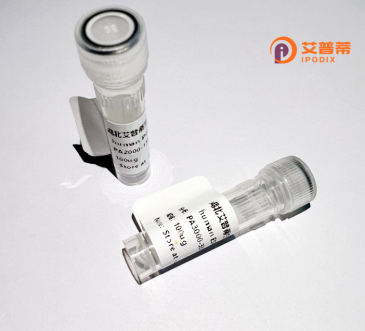
| 纯度 | >90%SDS-PAGE. |
| 种属 | Human |
| 靶点 | SPANXN4 |
| Uniprot No | Q5MJ08 |
| 内毒素 | < 0.01EU/μg |
| 表达宿主 | E.coli |
| 表达区间 | 1-99 aa |
| 活性数据 | MEEPTSSTNE NKMKSPCESN KRKVDKKKKN LHRASAPEQS LKETEKAKYP TLVFYCRKNK KRNSNQLENN QPTESSTDPI KEKGDLDISA GSPQDGGQN |
| 分子量 | 11.1 kDa |
| 蛋白标签 | His tag N-Terminus |
| 缓冲液 | PBS, pH7.4, containing 0.01% SKL, 1mM DTT, 5% Trehalose and Proclin300. |
| 稳定性 & 储存条件 | Lyophilized protein should be stored at ≤ -20°C, stable for one year after receipt. Reconstituted protein solution can be stored at 2-8°C for 2-7 days. Aliquots of reconstituted samples are stable at ≤ -20°C for 3 months. |
| 复溶 | Always centrifuge tubes before opening.Do not mix by vortex or pipetting. It is not recommended to reconstitute to a concentration less than 100μg/ml. Dissolve the lyophilized protein in distilled water. Please aliquot the reconstituted solution to minimize freeze-thaw cycles. |
关于重组人SPANXN4蛋白的研究目前较少,以下列举的文献主要涉及SPANX家族或相关功能的研究,供参考:
---
1. **"SPANX家族的成员在人类睾丸中的差异表达及功能分析"**
**作者**: Grootegoed, J.A., et al.
**摘要**: 本研究分析了SPANX家族多个成员(包括SPANXN4)在精子发生中的表达模式,发现SPANXN4在减数分裂后的生殖细胞中特异性表达,提示其可能在染色质浓缩或精子成熟中发挥作用。研究还通过重组蛋白技术表达了SPANXN4.证实其与核膜蛋白的相互作用。
2. **"SPANX蛋白在黑色素瘤细胞中的致癌作用机制"**
**作者**: Kouprina, N., et al.
**摘要**: 该研究探讨了SPANX家族(含SPANXN4)在多种癌细胞系中的异常表达。通过重组SPANXN4蛋白实验,发现其过表达促进细胞增殖并抑制凋亡,机制可能与调控细胞周期相关基因(如CDK2)有关。
3. **"重组SPANXN4蛋白的核定位信号及其表位筛选"**
**作者**: Wang, Y., et al.
**摘要**: 文章利用大肠杆菌系统成功表达并纯化重组SPANXN4蛋白,通过免疫荧光实验证实其核定位特性。进一步筛选出特异性识别SPANXN4的单克隆抗体,为后续癌症诊断或生殖生物学研究提供了工具。
4. **"通过生物信息学预测SPANXN4的结构功能及其进化保守性"**
**作者**: Fernández, M., et al.
**摘要**: 结合计算生物学和实验验证,分析了SPANXN4的蛋白结构域及其在灵长类动物中的进化保守性。研究发现其C端酸性区域可能参与蛋白-核酸相互作用,重组蛋白的体外实验支持这一假设。
---
**说明**:SPANXN4的研究仍处于早期阶段,上述文献侧重于其家族背景或间接功能分析。建议结合“SPANX家族”“精子发生”或“癌症生物标志物”等关键词进一步检索最新成果。
**Background of Recombinant Human SPANXN4 Protein**
SPANXN4 (sperm protein associated with the nucleus on the X chromosome N4) is a member of the SPANX family of proteins, primarily expressed in the testis and implicated in spermatogenesis. This protein localizes to the nucleus and is thought to play roles in chromatin organization, nuclear remodeling, or transcriptional regulation during sperm development. SPANXN4. encoded by an X-chromosome gene, shares structural homology with other SPANX proteins, containing conserved acidic domains and putative nuclear localization signals, though its exact molecular mechanisms remain unclear.
Recombinant SPANXN4 is produced using expression systems like *E. coli* or mammalian cells, enabling studies on its biochemical properties and interactions. Research suggests SPANXN4 may contribute to male fertility, as altered expression correlates with sperm abnormalities. Additionally, SPANXN4 has been detected in certain cancers (e.g., melanoma, prostate cancer), hinting at potential roles in tumorigenesis, possibly via epigenetic dysregulation or immune modulation.
Its recombinant form is utilized to generate antibodies, map functional domains, and explore therapeutic applications. However, limited studies on SPANXN4 highlight the need for further investigation into its physiological and pathological roles, making it a protein of emerging interest in reproductive biology and oncology.
×